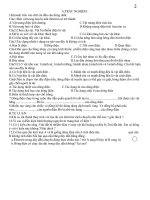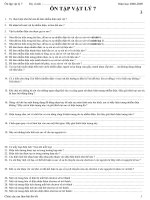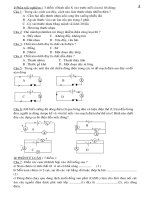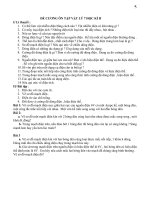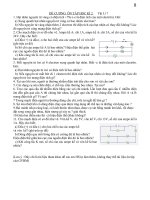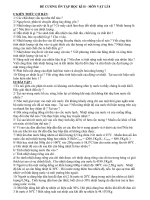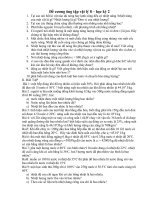Đề cương ôn thi Phân tích diễn ngôn tiếng Anh hay, chọn lọc
Bạn đang xem bản rút gọn của tài liệu. Xem và tải ngay bản đầy đủ của tài liệu tại đây (130.78 KB, 13 trang )
DISCUSSION QUESTION
Question 1. The difference between 2 approaches to text
Basically, there are 2 approaches to text.
The first sees text as “the verbal record of a communicative act” (Brown
and Yule, 1983:6) or as “the linguistic product of communicative
process”(widdowson, 1984:100).
The second approach tends to see text as a semantic or communicative
category. Eg, Halliday and Hasan, 1976 view text as a “semantic unit”
characterised by cohesion or a frameword that is logical and general.
Question 2. The difference between transactional and interaction
function of language
Transactional function is basically the transmission of information, ideas
or thought. We call the language which is used to conveyed factual or
propositional information primarity transactional language. It is used to express
content.
According to Lyons(1977:32) the notion of communication is readily used
of feelings, moods, attitudes. Written language is used primarily for
transactional purpose.
Interactional function is concerned with maintaining or establishing
social relationships. It is the phatic use of the language to negotiate rolerelationships, peer-solidarity, the exchange of turn in conversation, the saving of
face of both speaker and hearer.
It expresses social relations and personal attitudes. Spoken language is
primarily interactional.
Question 3. Present your understanding of the informativity in
discourse
To measure the informativity of a discourse, we should pay attention to
the notion of choice and probability.
1
A discourse (according to Bell) is seen as the relation of choices made
from among sets of options. At each point where a choice is made, there are
actual choices which are more or less probable.
The less probable and predictable a choice, is the more informative and
interesting a discourse is. If a discourse contains too much information (too
many lexical units) it may become unreadable. But if it contains too little
information, it is readable but not worth reading at all.
Eg, food contamination is one of the most critical issues in developing
countries (high informative). Poisonous food is one of the most serious problems
in developing countries (less informative)
Question 4. context and an example of the role of the context in the
interpretation of a discourse
Context seems just to be the minimal stretch of language that helps to
understanding what is spoken or written. It is the non-linguistic factors that
contribute and constrain our interpretation or discourse and tell us what
proposition has been actually uttered.
We can know what kind of illocutionary force has been assigned by the
speaker to the proposition.
role of the context in the interpretation of a discourse
Context helps us disambiguate the interpretation that is most suitable and
appropriate. Context includes not only the relevant cotext but also the relevant
features of the situation of the utterance. Sometimes it is called “context of
situation”.
Eg, he is her hope for change in her life now (informing, commenting)
Question 5. The difference between context and cotext
Context is the minimal stretch of language. It refers linguistic factor and
make clear what sentence is uttered. It also tell us what proposition has been
assigned to the proposition by the speaker.
2
Cotext is stretch of language that occurs before or after the utterance
which needs to be interpreted. It refers no-linguistic factor and surrounds
sentence which help understand the meaning.
Question 6. Distinguish between the principle of local interpretation
and analogy
2 principles may be helpful in our reading of text. They are the principle
of local interpretation and analogy.
According to Brown & Yule, the principle of local interpretation
instructs the hearer not to construct a context any larger than he needs to arrive
at an interpretation.
The principle of analogy enables the hearer pr listener to interpret
discourse in light of his past experience and background knowledge. When the
hear encounters new situation, he selects from his memory a type of experience
he has generalized before, relates it to his background knowledge in order to
interpret it.
Question 7. The difference between anaphoric and cataphoric
reference.
There are 2 types of discourse reference: anaphotic if it points back or
catephoric if it points forward.
We need to look ahead in the text. This is a cohesive device which points
towards. It draws futher into the text in order to identify the elementd to which
the reference items refer.
In the other hand, anaphoric items which point the reader and listener
backwards to a previously mentioned entity, process or state of affairs. It helps
us to understand the unit refered to by an anaphoric relevance we need to look
back in the text.
Eg, a man looks at the sun and remarks:”it’s beautiful”. “it” in the context
does not refer to anything that was said before, but relates to part of the situation
in which the speaker and the hearer are.
3
Question 8. The difference between presupposition and implicature
Presupposition is the assumptions that the speaker makes about what the
hearer is likely to accept without challenge or the common ground between the
speaker and the hearer.
It associated with linguistic forms and remains constant under negation
test. It is not subject to cancellation within one and the same utterance by one
and the same person. It also can be identified with the help of presupposition
triggers. Eg: he had gone there by bike before.
Implicature accounts for what a speaker can imply suggest or means as
distinct from what the speaker literally says. It associated with context and
reference. It is modifiable or changeable when the utterance is subject to
negation test.
It is likely to be cancelled. It also can be identified inference only and
based on explicit meaning and presupposition. Eg: it made me admire him a lot.
Question 9. topic of the sentence and the discourse
For some people, the term topic is associated with description of sentence
structure.
According to Hockett: the speaker announces a topic and then say
something about it. In many language, the grammatical subject is the marker of
the topic and the predicate indicates the comments. Eg:the boy likes foodball.
We are not concerned with politics.
However it may not always be the case. Eg: I wrote 2 letters. One I
posted. One I put in my pocket.
According to Palmer: sentence contains 2 parts, each of which carries
information: + the first is the theme (called topic) contains known information;
+ the second is the rheme (thuyết ngữ) (called comment) contains new
information.
For us, the importance thing is that we shall treat topic as “what is being
talked about”.
4
Discourse topic is a generalization or an abstraction. The expression of a
topic should be subjective. There are a number of ways of expressing the topic
of discourse. There are no such a thing as one correct expression of the topic for
any fragment of discourse. topic is what is being talked about. Eg: A story
can have different titles to which the topic of a text is equivalent.
Question 10. topic framework
The notion “topic” is considered as “what is being talked about”. Topic
framework may be seen as a composition of all the features of context activated
by the discourse participants.
It comprises all the activated features of context directly refered in the
text and needs to be called upon to interpret it. The speaker or writer usually
operates within this topic framework to produce language.
We will have sense that the sentence are connected topically. Relevance is
important indicator of the topic framework. The information provided is not out
off place, as it were.
Question 11. theme and the types of theme
Theme is usually expressed by the left most constituent of the sentence,
refers of what the speaker nominated as the subject of what he will talk about in
the theme.
- 2 types of themes: (from formal perspective): marked and unmarked.
+Unmarked theme: coincided (trùng hợp) with the subject in the
affirmative, the auxiliary and wh-inquestion, the first verb in the imperative (bắt
buộc).
+ Marked theme: the first element is not coincident with the above
element.
Eg: tomorrow, I ‘ll go to see him if I have time (unmarked), she is pretty,
but not as the way he expected (marked)
Question 12. the approaches to discourse analysis
5
According to Clyne, discourse analysis moves into 3 directions:
+comparing native discourse across culture;
+ examining the discourse of non-native speakers in a second language;
+examining and comparing the discourse of people of different cultural
and linguistic backgrounds interacting either in a lingua franca or in one of the
interlocutors’ language.
Eg: the influence of different dialects on English second languge learner’s
speaking skill at HDU.
Question 13. discourse and the functions of discourse analysis
Discourse constitutes the social. Three dimensions of the social are
distinguished – knowledge, social relations and social identify and these
correspond respectively to three major functions of language….Discourse is
shaped by relations of power and invested in ideologies. (Fairclough, 1992:8).
Functions: the study of discourse is the study of any aspect of language in
use (grammatical meaning, the use of language,…)(Fasold 1990:65).
The analysis of discourse is necessarily, the analysis of language in use as
such, it can nit be restricted to the description of linguistic forms independent of
the purposes or functions which these forms are designed to serve in human
affairs.
Question 14. The 7 macro functions of language
-1. the emotive function (biểu cảm):communicating the inner states and
emotions of the addresser (“oh, no!” . “uhm!” , “Fantastic!” and swear words
used as exclamations).
-2. the directive function (chỉ thị): seeking to affect the behaviour of the
addressee (“please, help me”. “Shut up”, “I’am warning you”).
-3. the phatic function( xã giao):opening the channel or checking that it is
working either for social reasons (“hello”, “lovely weather”, “do you come here
often?”) or for practical ones (“can you hear me?” “Are you still there?” “Can
you read my writing?”).
6
-4. the poetic function (thơ ca):in which the particular form chosen is the
essence of the message (the advertising beanz meanz heinz would lose its point
if it were paraphrases as “if you are buying beans, you will naturally buy heinz).
-5. the referential function (tham chiếu):carrying information.
-6. the metalingguistic function (siêu ngôn):focusing attention upon the
code itself, to clarify it or to renegotiate it (“what does this word here mean?”,
“will” and “shall” mean the same thing nowadays).
-7. the contextual function (ngữ cảnh) :creating a particular kind of
communication (right, let’s start lecture, it’s just a game)
Question 15. The criteria of the distinction between spoken and
written language
-1. manner of production:+ the speaker could be supported by gestures,
posture, more demanding circumstance. +The speaker can see spontaneous
reactions from the audience. + The speaker may refine the expressions.
+ The writer could be chosen with words, can not see the reaction from
audience. +The writer is under no pressure in terms of the monitoring. +The
writer has many opportunities to polish the ideas by changing them till they
satisfy the author’s view
-2. forms: + in spoken language, incomplete sentence; “and” is very
common; active declarative forms; topic comment structure is common.
Active constructions are commonly used in formal speech; the same syntactic
forms are repeat: I consider that problem, I consider that matter,…; + in written
language, passive structures are common in formal speech, premodified noun
phrases occur frequently, is metalinggual markers to connect clauses. Generally
various ways of expression.
-3. the presentation of discourse: text: in spoken, is verbal record of the
communication act, the interpretation is very subjective, difficult to be
transcribed; in written, different type-face, different size of paper, different font,
presentation.
7
Question 16. 7 standards of a discourse according to Bell
According to Bell (1991) in order for a language unit to be identified as a
discourse, it must meet at least 7 standards, for the sake of brevity, it could be
counted as five:
-1, cohesion and coherence:
cohesion is concerned with formal surface structures to interact with
underlying semantic relations or underlying functional coherence to create
textual unity. Cohesion is seen as one of the ways to indicate coherence.
Coherence,in contract, is concerned with the sequencing of the
configuration of the concepts and the relation of the textual world which
underlie and are realized by surface text.
-2. intentionality and acceptability:the producer of the text must intend
it to contribute towards some goal and the receiver of it must accept that it is,
indeed, fulfilling some such purpose.
-3. informativity:is seen as the relation of choices made from among sets
of options. At each point where a choice is made, there are actual choices which
are more or less probable. The less probable and predictable a choice is the more
informative and interesting a discourse is.
-4. relevance:a discourse must possess a degree of relevance or
situationality. Eg: Vietnamese takeaway could be only understood in the
context. “sale off/ on sale/ for sale”
-5.intertextuality: the context creates the discourse as much as the
discourse as much as the discourse creates the context. This means that part of
the environment for any discourse is a set of previous discourse, discourse that
are taken for granted as shared among those taking part.
Question 17. the difference between cohesion (thống nhất) and
coherence (mạch lạc)
Cohesion refers to the formal relationship that causes texts to cohere or
stick together. It is indicates by grammatical, logical and lexical relationships
8
found among or between the sentences of a text. It involves the formal links
which exist between sentences.
In contrast, coherence refers to the type of semantic or rhetorical
relationships that underline texts. It can obtain on basis of relevance, thecooperative principle, the common shares background knowledge between
participants in a speech event and discourse is structured, as well.
Question 18. The components of context according to Firth and
Halliday
Firth believes that a context of situation should embrace the following
categories:
-1. the relevant features of participant: (speaker, writer)
+ verbal action of the participants; + non-verbal action
-2, the relevant objects.
-3, the effect of the verbal action/ later,
According to Halliday develops these concepts into what he terms: fields, tenor,
mode of discourse. +Field of discourse refers to the subject matter of the
discourse, which is what the speaker talks about. +Tenor is concerned with the
interpersonal relations between the participants. + mode is about the channels or
the ways by which discourse is conducts.
Question 19. The components of context according to Hymes
- Addressor and addressee: writer, speaker, reader….
- Audience: overhearer, produces the utterance
- Topic: range of languge used
- Setting: location or time: where, when, postures, gestures…
- Channel: how to contact between participants is maintained
- Code: what language or style, dialect of language is used
- Message form: what forms are intended: fairy tales, love story
- Event: nature of communicative event within which a text embedded
- Key: evaluation of the text
9
- Purpose: outcome which the participant wish to happen as a result in the
communicative event
Question 20. The components of speech act according to Austin
-1. Austin also emphasizes the conventional nature of thee performative
act and te fact that an agreed procedure must be followed.
There are four felicity conditions:
A,there must exist an accepted conventional procedure, having certain
conventional effect, that the procedure includes the uttering of certain words by
certain persons in certain circumstances.
B, the particular persons and circumstances in a given case must be
appropriate for the invocation of the particular procedure invokes. The words
must be uttered by the appropriate person, apart from the correct and appropriate
words.
C. the procedure must be executes by all participants both correctly.
D, and completely. The last 2 conditions cover misfires which occur in
spite of the fulfillment of the first 2 conditions.
-2. a second distinction Austin draws is between explicit and implicit
performatives.
An explicit performative is one which contains performative verb
whereas an implicit one conveys implicatures.this distinction applies, in
principle, to both constative, non-constative utterances.
Question 21.The classification of speech act according to Austin
Austin’s theory distinguishes 3 kinds of acts involved in saying:
locutionary, illocutionary, perlocutionary.
-A locutionary act is the act of saying something in the full sense of say.
-An illocutionary act is an act performed in saying something, the act
identified by the explicuit performative. According to Autin, he grouped
illocutionary into 5 classes:
10
+ verdictives: typified by the giving of a verdict by a jury, umprire,
arbitrator, such as acquit, grade…
+ exercitive: which are the excercising of power, rights or influence such
as appoint, order, advise….
+ commissives: commit the speaker to doing something, but also include
declaration such as promise, guarantee, bet…
+ behabitivies: a miscellaneous groups concerned with attitudes and social
behavior such as apologies, bless
+ expositives: clarify how utterances fit into ongoing discourse, or how
they are being used argue, postulate, affirm…
-A perlocutionary act is the act performed by or as a result of saying.
Question 22. The classification of speech act according to Searl
Searl’s system includes: directives, commisives, representative, declaratives,
expressives.
1. directives: gets people to something. Eg: how many times do I have to
tell you? Realized by a wide range of forms, sentences, questions,…
2. commisives: functions as promises or refusals for action. Eg: maybe I
can do that to. May vary in strength, may be strong or highly hedge in positive
and negative directions.
3.representatives can be judged for truth value, the purpose is to inform,
may vary in terms of how hedged or aggravated the assertion might be,
expressed by the use of modal verb. eg: I went home yesterday.
4.declaratives bring about a new state os beings. eg: the chair man says:
“I declare the meeting open” = > a change really take place, people start to make
speeches and address the meeting and so on.
5. expressives: they are expressions of joys, disappointment: what a great
day is a joy.
Question 23. The components of a narrative according to Thondyke
11
According to Thorndyke, simple narrative stories may result from a set of
hierarchically organized components as follows:
1.story:setting,theme,plot,resolution.
6.attempt: event,episode.
2,setting: characters,location,time.
7.outcome: event,state.
3.theme:(event),goal.
8. resolution: event,state.
4.plot: episode.
9.Subgoal,goal: desired state.
5.episode: subgoal,attempt,outcome.
10.character, location time: state.
Question 24. The differences between default elements and frame
Default elements are the knowledge that is stored in our mind as single
easily accessible unit. Understanding discourse is essentially a process of
retrieving stored information from memory and relating to the encountered
discourse Potluck.
A frames a fixed representation of background knowledge and
experience. What people do in terms of producing language is to fit what one is
told into the framework established by what one knows already.
Question 25. The differences between scenarios, scripts and schemata
1. scenarios: it is like a film in that it activates certain role slots into the
representation. A hospital situation will certainly bring to doctor role, the nurse
or patient roles into action.
2,scripts: it incorporates a standard dequence of event describing a
situation. It can be treated as action stereotypes and can work well with routines
activities such as going to a doctor, vistting a friend,…
3.schemata: essential higher level complex knowledge structures which
function as ideational scaffolding. They are organized background knowledge
which leads us to expect or predict aspects in our interpretation of discourse.
BT
1. This is an extract from an article of economic issue, the dominant cohesive
means are association, reiteration, and substitution, it is seen that, lexical and
grammatical cohesion is dominant, especially, association chain is rather clearly
12
shown in the essay with 4 cases out of 4 sentences. The repetition of the word
euro or dollar is also one of the prominent phenomenon in the extract. It is
proved that the density of lexical items related to currency is deliberately
chosen.
2.
This extract is about a state of human emotion: hatred. The most common
cohesive devices are lexical ones. It is reconized that association, reitereation
and synonyms are the major ones among them, and those chains mainly connect
with human, life, society, and emotion. They reflect human living environment
and their feelings. The author tends to use them instead of grammatical or
logical cohesion which are typical of narrative and argumentation. In my
opinion, it is relevant in an extract of scientific or socio-psychological comment.
13

